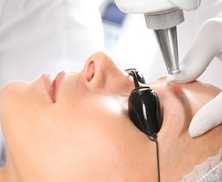Scarring is the body’s natural response to damage sustained by the skin, or by the dermis in particular. The healing process is designed to prevent blood loss and to repair and replace damaged tissue as quickly as possible.
Unfortunately, some more severe forms of active acne can cause irreversible damage to the skin. As pores become blocked with sebum and dead skin cells, the pressure begins to increase, and if acne-causing bacteria start to proliferate, the blemish can become inflamed and infected.
The more inflamed a spot is, the more likely it is to cause scarring. Acne also has a tendency to produce scars that have a sunken or pitted appearance, due to the loss of tissue; this is why squeezing spots is to be avoided: doing so can forced infection deeper into the skin, causing increased tissue loss.
In addition to the ‘ice-pick’ appearance of the scarring, acne scars can also be red in colour. This is not a change in pigmentation as such, but is caused by the inflammation of the spot, and should fade away on its own, albeit very slowly. Acne scars may not be sore or filled with pus, but they can be difficult to hide and can cause just as much disappointment and distress as active acne.































